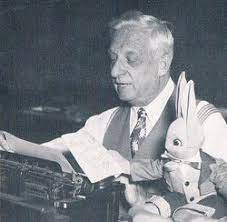This is the third in a series of posts about the Amherst Writers Walk, a self-guided tour of the houses where 12 renowned writers lived. Here are links to Part One and Part Two.
By Nick Grabbe
When they moved to Amherst in 1950, they were the most popular and prolific writers of children’s books in the U.S.

So when Howard Garis left his house at 97 Spring Street and walked around town, groups of children would often follow him and ask him to tell them a story, or just stare at him. That’s because he was the famous author of more than 15,000 Uncle Wiggily stories between 1910 and 1962. They were collected in 79 books and had sold over 15 million copies by then.
The books are still available and have been translated into many languages. Uncle Wiggily Longears is an engaging elderly rabbit who wears a top hat, uses a cane, and gives children a sense of optimism and adventure. Howard Garis (1873-1962) was so famous in 1950 that his arrival merited an announcement in the local newspaper.

Uncle Wiggily board games and toys sold in the millions, and the name entered popular culture. An Uncle Wiggily book is featured in “Forrest Gump,” and the familiar name has been used by a rock band and a chain of Baltimore ice cream shops.
Garis’s earlier publishing achievements were broad and astounding, but didn’t gain him the fame and fortune of the Uncle Wiggily stories. That’s because he and his wife Lilian Garis (1873-1954) were ghostwriters for a syndicate that gave them measly compensation, considering the popularity of their books.

Garis wrote the popular Tom Swift books about a boy scientist and tinkerer; Apple Computers co-founder Steve Wozniak called Tom Swift his role model. He also wrote the Baseball Joe and Camp Fire Girls books and many others, using a variety of pseudonyms. It is said that he worked every day but Sunday and could turn out a book in six to eight days. He wrote over 300 books for the syndicate.
Howard and Lilian Garis both wrote books about the Bobbsey Twins under the pseudonym Laura Lee Hope. The books feature an upper-middle-class family with two sets of twins, ages 12 and 6. There have been 72 books in this series over 75 years (1904-1979), and the Garises wrote the first 27 of them.

Lilian, a former suffragette, met Howard when they both wrote for the Newark Evening News. Lilian wrote hundreds of books between 1915 and the early 1940s, about girls named Judy Jordan, Nancy Brandon and others. She also wrote books under her own name, as did Howard.
But Lilian Garis fancied herself an expert on stocks, and she invested their savings in the market, which crashed in 1929. The Uncle Wiggily books secured their financial security.

Their son Roger was also a writer, and had some success in magazines and scripts for early television. But he struggled with mental illness and difficulty getting out of the shadow of his famous parents. His daughter, Leslie Garis, wrote a poignant memoir in 2007 called “House of Happy Endings” about growing up in the house on Spring Street in the 1950s with her parents and grandparents amid her father’s mental disintegration. It shows how deep sadness can lie behind a facade of idyllic serenity.

The house, on the corner of Spring and Dickinson Streets, was known as “The Dell” and was frequently visited by poet Robert Frost, a close friend of Howard Garis. It was built in the Craftsman and Revival styles. It is now the headquarters of Five Colleges Inc.
Shirley Graham Du Bois (1896-1977), who married W.E.B. Du Bois when he was 83 and she was 54, was a notable writer and activist also. When her husband died in 1963, she gave his papers to the University of Massachusetts and was a visiting lecturer there. She lived at 30 Boltwood Avenue, now the Lord Jeffery Inn, in the 1970s.

While a student at Oberlin College, Du Bois wrote and produced an opera in 1932 called “Tom Toms: An Epic Story of Music and the Negro.” It attracted 10,000 people to the first performance, 15,000 to the second, including the Ohio governor. She is said to be the first African American to write and produce an opera with an all-black cast. The score was lost but was rediscovered in 2001.
Between 1932 and 1975, Du Bois wrote six plays and 14 books, including biographies for young adults of botanist George Washington Carver, poet Phyllis Wheatley, Frederick Douglas and Booker T. Washington. She wrote a play called “It’s Morning” about an enslaved mother contemplating infanticide. She used theater to tell black women’s story from their perspective.
Du Bois was also one of the first field secretaries of the NAACP and organized branches all over the country. She defended people protesting racial injustice on a military base. Because she was a member of the Communist Party, her work didn’t get as much attention as it deserved. She ultimately emigrated to Africa, dying in Beijing, as a citizen of Tanzania.
One of her last novels, “Zulu Heart,” included a sympathetic portrait of whites in South Africa despite racial conflict there.
The third house on this part of the Amherst Writers Walk isn’t there anymore. Noah Webster, the dictionary pioneer and standardizer of the American version of English, lived at 46 Main Street from 1812 to 1822.

Webster wanted Americans to have a national identity separate from England’s, but that was difficult because in the late 18th century there were many regional dialects.
In 1783 he published what became known as “The Blue-Backed Speller.” It taught children spelling rules and simplified words. He took the “u” out of English words like “colour” and “honour,” removed a “g” from “waggon, kicked off the “k” in “musick” and reversed the final letters of “theatre” and “centre.”
Webster spent almost 30 years compiling his dictionary. He introduced distinctly American words, many derived from native languages, such as skunk, squash, hickory, opossum, lengthy, Congress and caucus. In all, he added about 5,000 words to the language. He died in 1843 without having sold many copies, in part because it cost $15 to $20, which was then an enormous amount.
Webster also was an advisor to George Washington, wrote his own edition of the Bible, and counted houses in major cities, leading to the first census. There’s a statue of him on the Amherst College campus.
The Amherst Writers Walk began in a course at the University of Massachusetts on public history. It was realized by the Amherst Historical Commission, funded by Community Preservation Act funds, and installed by the Department of Public Works in 2021,

Thanks for this fascinating and informative article, Current. My previous knowledge of Amherst literati didn’t go beyond Emily Dickinson.
LikeLike
Thank you so much for this series!! Today’s is especially good, well written and with humor (no u). What fun to read in the morning.
Joyce Hatch
LikeLike
Thanks, Nick. This is a wonderful piece. It was great to be back in Amherst April 2-3.
Maryelise Lamet
LikeLike
I grew up reading the Bobbsey twins books in India…who knew the authors lived here. Thanks for all this information, Nick.
LikeLike
[…] Part Three: Howard and Lilian Garis, Shirley Graham Du Bois and Noah Webster […]
LikeLike